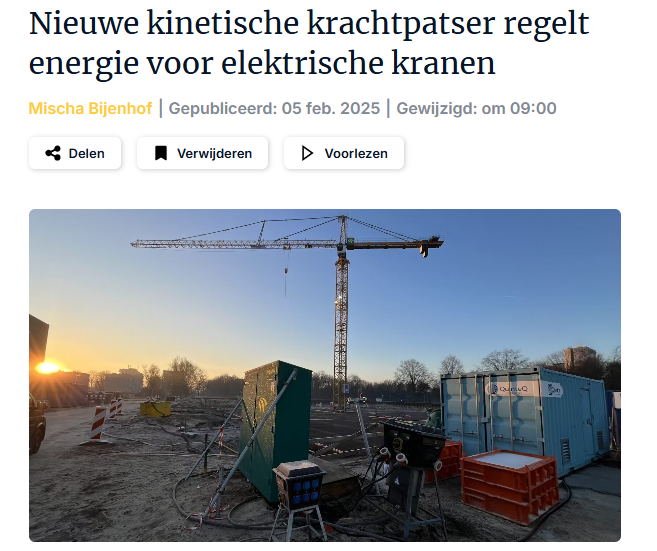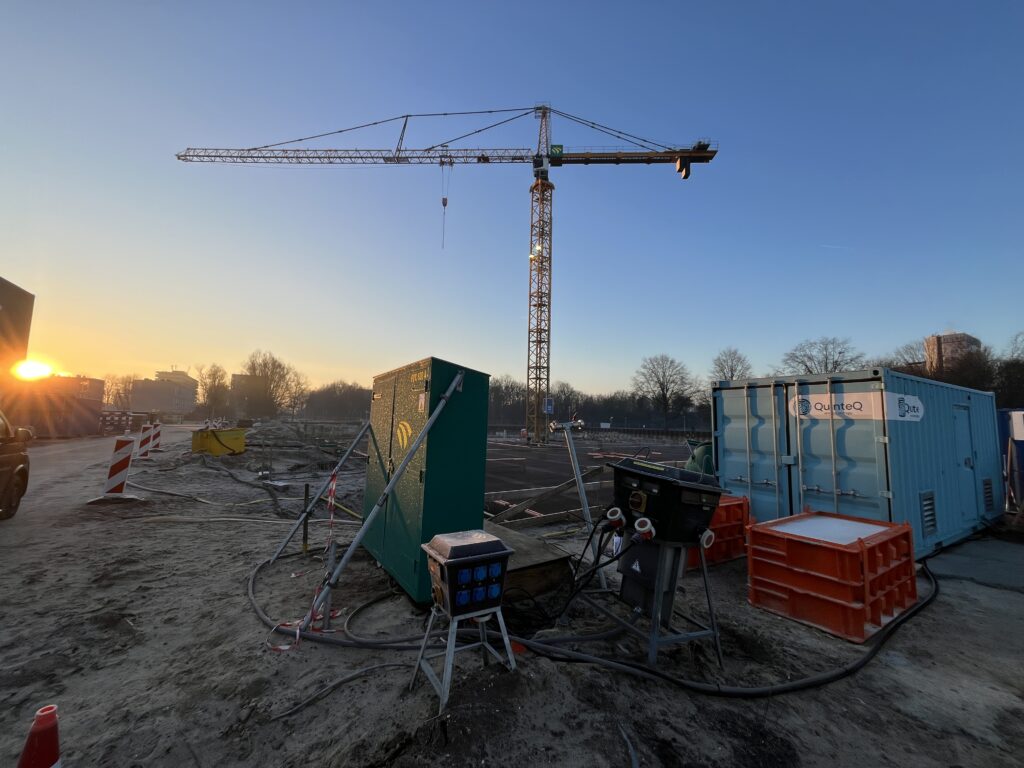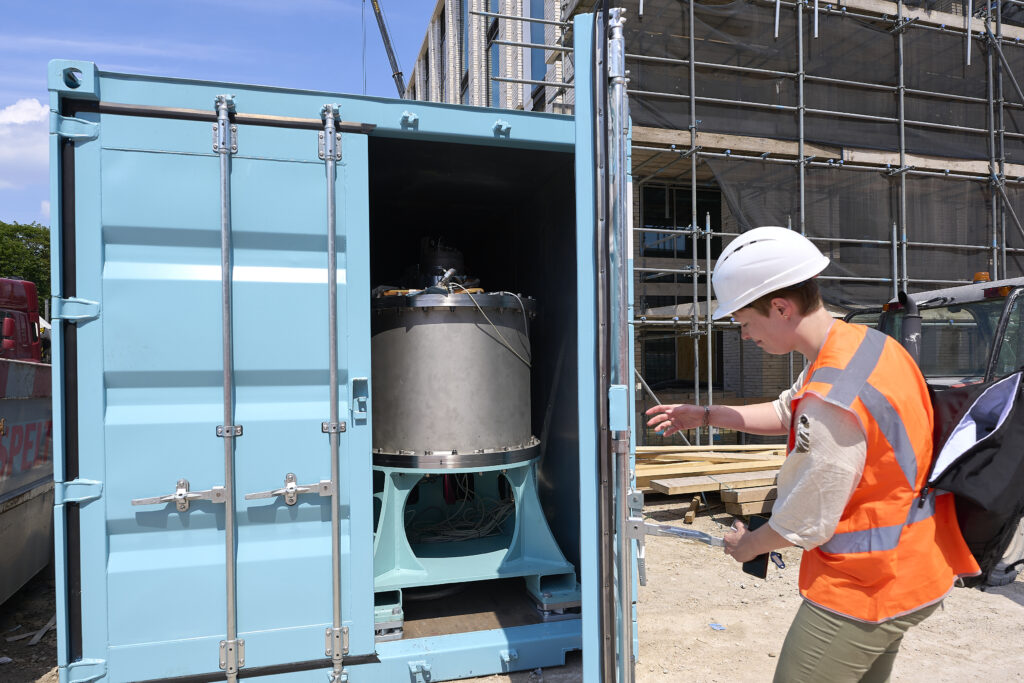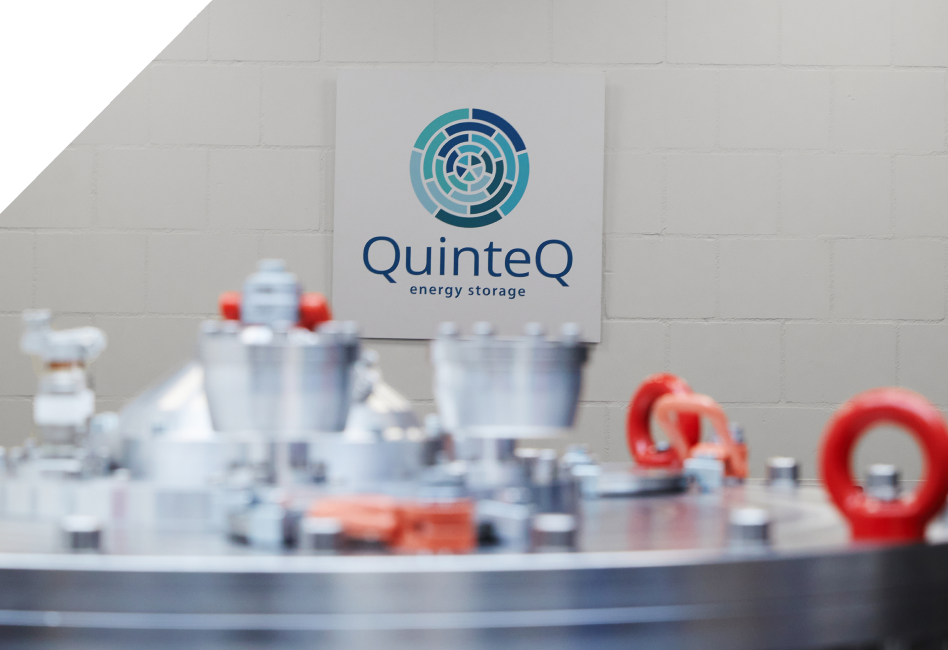Following the successful completion of the Fly-High-Five project, QuinteQ is pleased to share this feature in Bouwmachines magazine: “New kinetic powerhouse controls power for electric cranes”. We have taken the liberty to translate this originally Dutch text to English for our international followers.

New kinetic powerhouse controls power for electric cranes
Many emission-free construction plans are delayed by the lack of adequate power supplies. Tech pioneer QuinteQ from Culemborg is looking for an alternative to increasingly heavy connections: they developed a kinetic energy storage. In a flywheel, with aviation technology from Boeing. The test phase of ‘Thor’ has now been completed.
When QuinteQ offered the prototype of their flywheel for field testing in 2023, there was some skepticism among the established names in the energy supplier market. No one had ever seriously researched the possibility of kinetic energy storage. The Culemborg company itself had every confidence in it. Construction company BAM went into business with the young entrepreneurs and tested the flywheel in Amsterdam during the construction of a student housing complex.
This was followed by an intensive second test phase under the name Fly-High-Five, in which, in addition to BAM, construction companies Dura Vermeer, VolkerWessels, De Vries en Verburg Bouw and Hemubo also participated. Van der Spek Vianen provided the expertise for the construction cranes and collected measurement data. This test phase has now been completed and QuinteQ updated interested parties on the future plans at its own headquarters.
Variable energy demand
An interesting side-effect of Fly-High-Five was the observation that the flywheel can also be used perfectly for construction hoists. “We learned a lot during the first demo with BAM,” says Business Development Manager Timo Pauel of QuinteQ. “The flywheel was initially used to absorb peak loads when using tower cranes. That is why we first had to discover exactly how large that peak load is. We discovered that there are many variables in the power demand, which makes the data difficult to generalize. For example, the lifting load, but also the overlap between different cranes and ultimately the way the operator works determine the amount of energy required.”
An example of such a variable is that when more than one crane is used, the possibility of overlap occurs, but from a certain number of cranes the chance of this actually decreases again, since each crane performs its own specific task that usually has a fixed moment in the chain. “What is a worst-case scenario on paper, namely that all cranes present demand power at the same time, rarely occurs in practice,” Pauel explains.

Thor
The construction companies that are united in the Fly-High-Five project have shared their experiences, after which QuinteQ has further developed the prototype that is now ready for production. QuinteQ expects to be able to deliver the first copy in June, number five should roll off the production line in August and in January 2026 QuinteQ wants to have another ten copies of the flywheel ready.
In the meantime, the impressive piece of aerospace engineering has also been given a name. Thor, subtitled ‘the powerhouse of the construction site’, is set to become the solution for peak shaving on construction sites from this summer. Thor can be purchased, rented or leased and has a more modest housing than its nameless predecessor. Where the prototype of the flywheel was still housed in a twenty-foot container, QuinteQ is using a ten-foot shelter for the production model. “We actually already knew that it could be smaller,” says Pauel, “but in the test phase we could make good use of that extra space. Now that it’s really starting, we’re making everything as compact as possible. That’s good for the center of gravity in connection with transport, and there’s always a shortage of space on a construction site.”
QuinteQ provides the knowledge and the people for the placement and installation of Thor. “Certainly in the initial phase. It is pioneering technology, so we will help the users on their way. We do this, among other things, by looking at how the system can be scheduled. The conclusion after the test phase is that Thor has passed with flying colours. Pauel, pointing to the industrial hall: “It will certainly become a bit more crowded here in the near future.”

The technique
A flywheel stores energy through movement. When power is sent to the flywheel — for example, when the tower crane is not lifting — a motor-generator causes a spinning top, the flywheel, to rotate at an increasingly higher speed. In this way, electrical energy is converted into kinetic energy. The flywheel rotates in a metal container that serves as a safety barrier and a vacuum container. The vacuum, in combination with high-quality bearings, minimizes energy losses, so that the kinetic energy is efficiently retained. When power is required from the grid — for example, when the tower crane starts lifting again — the motor-generator switches to the generator function and brakes the flywheel to generate electricity. This generated energy is then used to absorb peak loads from tower cranes and construction hoists.
The flywheel continuously alternates between charging and discharging. This principle of peak shaving drastically reduces the peak power of a construction site, which in many cases even makes a medium-voltage station redundant. The flywheel delivers a demand-driven power of 100-300 kW and contains 4kWh of energy.
Easier permit
Another important advantage of using kinetic energy storage over lithium batteries is that no harmful substances are involved. This makes it safer and more sustainable, because no scarce raw materials have to be flown in from geopolitically sensitive countries. In addition, the flywheel has the advantage that there is no additional fire hazard because no ‘thermal runway’ can occur. This makes it easier to install a flywheel in terms of permits than a chemical battery. In addition, there is no degeneration as with traditional, chemical batteries. QuinteQ currently mentions a lifespan of at least 15 years or 350,000 charging cycles, but that could well be many more. Timo Pauel: “The parts that wear out, such as the bearings, can simply be replaced. That is also what makes a flywheel such a great match on the construction site: it is a mechanical solution for a mechanical environment.”
A link to the original article can be found here: https://www.bouwmachines.nl/62652/thor-zorgt-voor-energieopslag-op-de-bouwplaats-met-vliegwiel-en-luchtvaartechnologie


